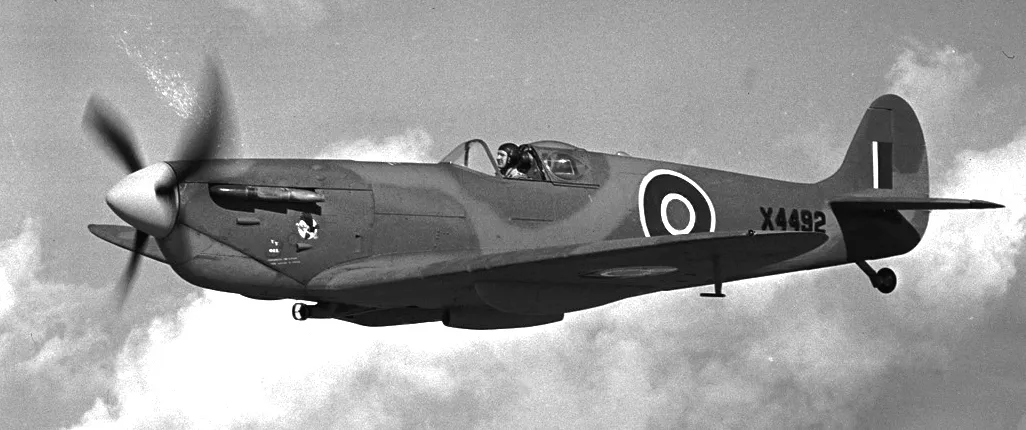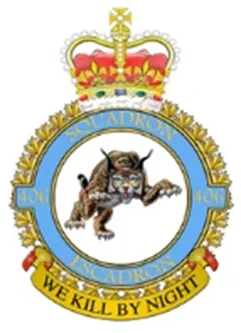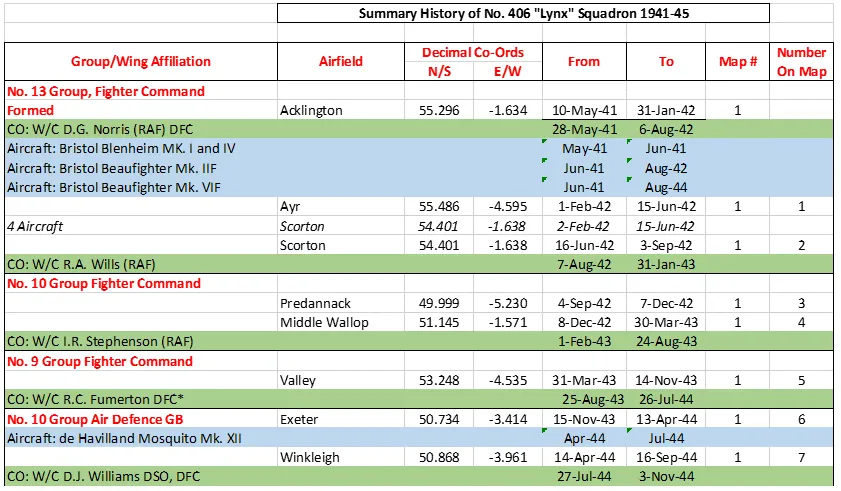Bennett, Harry Curd (Flight Lieutenant)
Killed in Action 1943-August-13


Birth Date: 1916
Born:
Parents: Son of George and Annie Bennett of Moose Jaw, Saskatchewan.
Spouse: Husband of Jeanne Olivia (nee Wimbles) Bennett, of Vancouver, British Columbia.
Home: Moose Jaw, Saskatchewan
Enlistment:
Enlistment Date: unkown date
Service
RCAF
Unit
406 Sqn- Squadron
We Kill By Night
Base
RAF Valley, Wales
Rank
Flight Lieutenant
Position
Pilot
Service Numbers
J/1390
Crew or Other Personnel
Spitfire P7530
Spitfire serial: P7530

Supermarine Spitfire Mk. VI, RCAF (Serial No. X4492), in flight, 26 Feb 1944.
The Supermarine Spitfire is a British single-seat fighter aircraft that was used by the Royal Air Force and other Allied countries before, during, and after World War II. Many variants of the Spitfire were built, using several wing configurations, and it was produced in greater numbers than any other British aircraft. It was also the only British fighter produced continuously throughout the war. The Spitfire continues to be popular among enthusiasts; around 70 remain airworthy, and many more are static exhibits in aviation museums throughout the world.
The Spitfire was designed as a short-range, high-performance interceptor aircraft by R. J. Mitchell, chief designer at Supermarine Aviation Works, which operated as a subsidiary of Vickers-Armstrong from 1928. Mitchell pushed the Spitfire's distinctive elliptical wing with cutting-edge sunken rivets (designed by Beverley Shenstone) to have the thinnest possible cross-section, helping give the aircraft a higher top speed than several contemporary fighters, including the Hawker Hurricane.
The Spitfire had detachable wing tips which were secured by two mounting points at the end of each main wing assembly. When the Spitfire took on a role as a high-altitude fighter (Marks VI and VII and some early Mk VIIIs), the standard wing tips were replaced by extended, "pointed" tips which increased the wingspan from 36 ft 10 in (11.23 m) to 40 ft 2 in (12.24 m). The other wing-tip variation, used by several Spitfire variants, was the "clipped" wing; the standard wing tips were replaced by wooden fairings which reduced the span by 3 ft 6 in (1.07 m). The wing tips used spruce formers for most of the internal structure with a light alloy skin attached using brass screws.
Due to a shortage of Brownings, which had been selected as the new standard rifle calibre machine gun for the RAF in 1934, early Spitfires were fitted with only four guns, with the other four fitted later. Early tests showed that, while the guns worked perfectly on the ground and at low altitudes, they tended to freeze at high altitude, especially the outer wing guns, because the RAF's Brownings had been modified to fire from an open bolt. While this prevented overheating of the cordite used in British ammunition, it allowed cold air to flow through the barrel unhindered. Supermarine did not fix the problem until October 1938, when they added hot air ducts from the rear of the wing-mounted radiators to the guns, and bulkheads around the gunbays to trap the hot air in the wing. Red fabric patches were doped over the gun ports to protect the guns from cold, dirt, and moisture until they were fired.
The first Rolls-Royce Griffon-engined Mk XII flew in August 1942, and first flew operationally with 41 Squadron in April 1943. This mark could nudge 400 mph (640 km/h) in level flight and climb to an altitude of 33,000 ft (10,000 m) in under nine minutes. As American fighters took over the long-range escorting of USAAF daylight bombing raids, the Griffon-engined Spitfires progressively took up the tactical air superiority role, and played a major role in intercepting V-1 flying bombs, while the Merlin-engined variants (mainly the Mk IX and the Packard-engined Mk XVI) were adapted to the fighter-bomber role. Although the later Griffon-engined marks lost some of the favourable handling characteristics of their Merlin-powered predecessors, they could still outmanoeuvre their main German foes and other, later American and British-designed fighters.Wikipedia
![]() Wikipedia Supermarine Spitfire
Wikipedia Supermarine Spitfire
Unit Desciption
406 Sqn We Kill By Night ("Lynx")
History of the Squadron during World War II (Aircraft: Blenheim I & IV, Beaufighter IIF & VIF, Mosquito XII & XXX)

The Squadron was formed at Acklington, Northumberland, UK  on May 10, 1941 as the RCAF's 5th squadron formed overseas, as a night-fighter unit. It flew Blenheim, Beaufighter and Mosquito aircraft in the night air defence of Great Britain role, before being re-designated as an Intruder squadron in November 1944. It was listed as the top scoring RAF/RCAF Intruder unit for the period November 27 1944 until the end of WWII. The squadron was disbanded at Predannack, Cornwall, UK
on May 10, 1941 as the RCAF's 5th squadron formed overseas, as a night-fighter unit. It flew Blenheim, Beaufighter and Mosquito aircraft in the night air defence of Great Britain role, before being re-designated as an Intruder squadron in November 1944. It was listed as the top scoring RAF/RCAF Intruder unit for the period November 27 1944 until the end of WWII. The squadron was disbanded at Predannack, Cornwall, UK  on Sep 1, 1945.
on Sep 1, 1945.
Overall, the squadron claimed 64 enemy aircraft destroyed, 7 probables and 47 damaged. Also claimed were 88 locomotives and many other vehicles. Squadron operational losses were 11 aircraft, 20 aircrew killed or missing and 2 POWs. The squadron personnel were awarded 3 DSOs, 1 second Bar to DFC, 1 Bar to DFC, 14 DFCs, 2 DFMs and 4 Mentioned in Dispatches. Battle Honours were: Defence of Britain 1941-45, English Channel and North Sea 1944, Fortress Europe 1943-44, France and Germany 1944-45: Biscay Ports 1944, Normandy 1944, Rhine: Biscay 1944.Wikipedia, Kostenuk and Griffin
Maps for Movements of 406 Squadron 1941-45

406 Sqn History Summary 1941-45

406 Sqn History Summary 1941-45 Page 2

History of the Squadron Post-WWII (Aircraft: Harvard II, Mitchell III, Silver Star, Expeditor, Otter, Sea King, Tracker, Cyclone)
The unit was re-formed as a reserve unit, 406 Tactical Bomber Squadron (Auxiliary) on 1 April 1947 at RCAF Station Saskatoon  . It flew B-25 Mitchell III light bombers, and also Harvard and T-33 Silver Star aircraft for army co-operation duties. It was re-designated 406 (Light Bomber) Squadron on 1 April 1949 and adopted the title City of Saskatoon in September 1952. In March 1958 under the name 406 Squadron, it was re-equipped with C-45 Expeditor and later CSR-123 Otter aircraft, and assigned to a light transport and emergency rescue role. The squadron was disbanded again on 1 April 1964 as a result of the reduction of the Auxiliary Force.
. It flew B-25 Mitchell III light bombers, and also Harvard and T-33 Silver Star aircraft for army co-operation duties. It was re-designated 406 (Light Bomber) Squadron on 1 April 1949 and adopted the title City of Saskatoon in September 1952. In March 1958 under the name 406 Squadron, it was re-equipped with C-45 Expeditor and later CSR-123 Otter aircraft, and assigned to a light transport and emergency rescue role. The squadron was disbanded again on 1 April 1964 as a result of the reduction of the Auxiliary Force.
The squadron was re-formed for a third time at CFB Shearwater, Nova Scotia  on 12 July 1972 as the 406 Maritime Operational Training Squadron, operating the CH-124 Sea King helicopter and the CP-121 Tracker ASW aircraft. In mid-1981, the operational Tracker squadron, 880 Maritime Reconnaissance Squadron, was transferred CFB Summerside, which left 406 Squadron only responsible for Sea King training. At the present time, the squadron trains pilots, Air Combat Systems Officers (ACSOs), and Airborne Electronic Sensor Operators (AES Ops) on the CH-148 Cyclone aircraft and flight operations relevant to the Maritime Helicopter (MH) role. In addition, the Squadron’s Technical Training Flight conducts a wide range of avionics and aviation courses for Cyclone technicians, as well as specialty maintenance courses. On an annual basis, between 200 and 300 students graduate from 406 Squadron. The squadron’s partner squadrons 423 Squadron in Shearwater, N.S., and 443 Squadron in Patricia Bay, B.C., employ 406 Squadron Cyclone graduates as integral members of helicopter air detachments aboard Her Majesty’s Canadian ships.
on 12 July 1972 as the 406 Maritime Operational Training Squadron, operating the CH-124 Sea King helicopter and the CP-121 Tracker ASW aircraft. In mid-1981, the operational Tracker squadron, 880 Maritime Reconnaissance Squadron, was transferred CFB Summerside, which left 406 Squadron only responsible for Sea King training. At the present time, the squadron trains pilots, Air Combat Systems Officers (ACSOs), and Airborne Electronic Sensor Operators (AES Ops) on the CH-148 Cyclone aircraft and flight operations relevant to the Maritime Helicopter (MH) role. In addition, the Squadron’s Technical Training Flight conducts a wide range of avionics and aviation courses for Cyclone technicians, as well as specialty maintenance courses. On an annual basis, between 200 and 300 students graduate from 406 Squadron. The squadron’s partner squadrons 423 Squadron in Shearwater, N.S., and 443 Squadron in Patricia Bay, B.C., employ 406 Squadron Cyclone graduates as integral members of helicopter air detachments aboard Her Majesty’s Canadian ships.